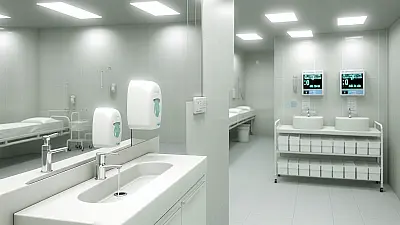CONWAY, SC - Oak View Health and Rehabilitation faced immediate jeopardy citations after state inspectors discovered a resident's heel wound had become infested with maggots, revealing critical breakdowns in wound care protocols and staff communication.

Delayed Discovery and Response to Maggot Infestation
The most serious violation centered on an 89-year-old male resident with Stage 4 pressure ulcers on both heels. On October 3, 2024, nursing staff discovered maggots in the resident's right heel wound during a routine dressing change. The resident had been admitted with what he described as "only blisters" that had deteriorated into severe pressure ulcers complicated by osteomyelitis and antibiotic-resistant infection.
Photos and videos provided by staff showed gauze soaked with brown discharge and multiple maggots in the wound cavity, with additional maggots observed moving on the bed beside the resident's foot. The discovery prompted immediate transfer to a hospital emergency department, where medical staff "flushed them out," according to the resident's own account.
The facility's wound care policy required weekly progress reports and prevention of infection symptoms unless clinically unavoidable. However, the infestation indicated a significant lapse in basic wound monitoring and care protocols.
Communication Breakdown Among Nursing Staff
A critical failure in communication emerged during the incident response. When the day shift nurse discovered the maggots around 6 PM, she contacted supervisory staff seeking guidance. According to testimony from Licensed Practical Nurse 6 (LPN6), the Assistant Director of Nursing initially instructed staff to "only dress the wound and not to clean it or do anything else."
LPN6 refused to follow this directive, stating she "was not going to allow that." She then contacted the Director of Nursing, who claimed she was unaware of the situation and directed her to call the physician. The doctor ordered immediate hospital transfer since they couldn't assess the wound remotely.
The Licensed Practical Nurse who first discovered the maggots (LPN7) reported being told not to document the incident and that the resident had a "history of parasitic infections" - though no such history was documented in the medical record. She was instructed to treat with Dakin's solution, but none was available on the unit at the time.
Medical Significance of Wound Care Failures
Maggot infestations in wounds represent a serious medical emergency. While medical maggots are sometimes used therapeutically under controlled conditions, spontaneous infestations indicate severe wound neglect and contamination. The presence of fly larvae suggests the wound was exposed to insects for an extended period, likely due to inadequate dressing changes or wound protection.
Stage 4 pressure ulcers extend through skin and tissue to underlying muscle or bone, requiring meticulous care to prevent complications. The resident's wound was complicated by osteomyelitis (bone infection) and methicillin-resistant staphylococcus aureus (MRSA), making proper wound care even more critical. Physician orders specified daily cleansing with Dakin's solution and specialized dressings, but the maggot infestation suggested these protocols weren't consistently followed.
Proper wound care protocols require sterile technique, appropriate moisture balance, and protection from environmental contamination. The facility's policy mandated heel boots and positioning aids to prevent further pressure injury, but staff noted the resident only wore protective boots in bed, not while in his wheelchair.
Industry Standards and Required Protocols
Federal nursing home regulations require facilities to ensure residents don't develop avoidable skin breakdown and that existing wounds receive appropriate treatment. Standard wound care protocols include:
- Daily assessment and documentation of wound characteristics - Sterile dressing changes using prescribed solutions and materials - Environmental protection to prevent contamination - Pressure relief through positioning and protective devices - Coordinated care between nursing staff and wound specialists
The facility employed a wound care specialist who visited weekly, but the infestation occurred between scheduled visits, highlighting the need for continuous monitoring by floor nursing staff.
Additional Issues Identified
Beyond the primary maggot infestation incident, the inspection revealed systemic issues in wound care management. Staff reported inconsistent knowledge about wound treatment protocols, with some nurses unfamiliar with residents' wound care needs during evening shifts when wound specialists weren't available.
The facility's immediate response included comprehensive wound audits for all residents, emergency pest control measures, and mandatory wound care education for all licensed nursing staff. Maintenance staff installed air curtain fans at facility entrances and increased pest monitoring protocols.
State inspectors classified this violation as "immediate jeopardy," the most serious category indicating substantial likelihood that the deficiency has caused or will cause serious injury, harm, impairment, or death. The facility was required to achieve substantial compliance before avoiding potential termination from Medicare and Medicaid programs.
The incident was ultimately resolved after the facility implemented corrective measures including enhanced staff training, improved communication protocols, and strengthened wound monitoring procedures. Weekly audits continued for eight weeks following the incident to ensure sustained compliance with wound care standards.
Full Inspection Report
The details above represent a summary of key findings. View the complete inspection report for Conway Manor from 2025-02-11 including all violations, facility responses, and corrective action plans.
💬 Join the Discussion
Comments are moderated. Please keep discussions respectful and relevant to nursing home care quality.